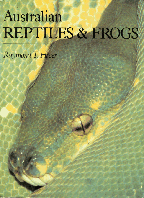 FURTHER USEFUL POINTS FOR KEEPING REPTILES AND FROGS
FURTHER USEFUL POINTS FOR KEEPING REPTILES AND FROGS
Reptiles and frogs are extremely clean animals, and their cages should be kept spotlessly clean and free of odor at all times. All feces, shed skins and other waste materials should be removed from the cage as soon as deposited. Nosel-style vacuum cleaners are often useful for cleaning out cages. Toxic disinfectants should not be used, as they will harm the herptiles.
When keeping an unfamiliar species, it is important to find out as much about it and its' keeping as is possible. This can be done through checking the literature, and speaking with others who keep or have kept the species (or related species) in question. In other words learn from other peoples' mistakes rather than make your own mistakes at the expense of the herptile.
A useful way to get a good idea of how to keep herptiles can be gained from seeing how other people, zoos, etc keep their herptiles. I should note here, that within Australia, it is an unfortunate fact that for many years we had a situation where many reptile and frog keepers did not have adequate facilities or take proper care of their herptiles. However this does not excuse anyone from failing to care for herptiles properly.
It is important to monitor (although not necessarily handle), captive herptiles on a regular basis, so that potential problems can be pre-empted.
Although handling herptiles generally poses no problems for either the herptile or its' keeper, a general recommendation is to keep handling of specimens to a minimum.
When herptiles live for several years and breed successfully, one can usually assume that the herptiles are being kept properly.
The author has always believed in taking accurate and detailed notes on reptiles and frogs held in captivity. Because little is known about the majority of species, captive notes are vital in finding out more about them and their biology. More importantly however, by keeping detailed records of specimens held, one can more easily detect potential problems before they become serious. Although the author has conducted some of the most detailed captive studies on Australian reptiles to date, there are still minimum records that need to be kept for all captive herptiles by their keepers.
These include the following for each specimen:
1/ Species (and some identification code or name for the particular specimen).
2/ Source obtained from and/or original source in wild.
3/ Details (Recorded) of the housing of the specimen, including climatic information. (Necessary for the identification of potential housing problems or improvements).
4/ Accurate growth records (By taking measurements)
5/ Feeding records
6/ Sloughing records for snakes
7/ All 'unusual' behavior recorded.
8/ Other miscellaneous information.
The records on each herptile should be stored in a safe place close to the herptile/s in question, so that they can be referred to as necessary.
The records must be held for at least the life of the herptile, and preferably indefinitely. The recording system should be designed in such a manner that additions can be made over several years.
By consulting records one can more easily plan new cages, or adjustments to cages for herptiles already held. When keeping herptiles one must make decisions based on facts, and not take 'stabs in the dark' when planning for their welfare.
New heptiles should be quarantined (kept separate and any ailments fully treated), before being placed with other captive herptiles in a collection. This is to prevent the possibility of introduced diseases wiping out a collection. One should systematically remove any internal parasites present, even if they don't appear to be causing any problems. Keeping herptiles is not as simple as keeping dogs, cats, and other 'pets'. Before deciding to keep herptiles one should take these facts
into consideration.
To continue to the rest of this section (Captive breeding)

The above was from the book Australian Reptiles and Frogs by Raymond Hoser and now available on a fantastic CD-Rom along with a vast amount of other information, papers and the like on reptiles, frogs and other wildlife.